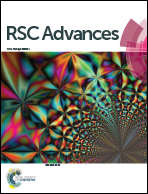Tetrazole-based infinite coordination polymer for encapsulation of TiO2 and its potential application for fabrication of ZnO@TiO2 core–shell structures†
Abstract
A new and facile technique for the preparation of ZnO@TiO2 core–shell nano/micro sphere structures from tetrazolate ligand, (1,3-bis(tetrazol-5-ylmethyl)benzene (btb)), was addressed. Via a solvent-induced precipitation method, nanoparticles of TiO2 bearing Rhodamine B were encapsulated into the Zn(btb) hollow spheres. The resulting polymeric carriers were characterized by SEM, HRTEM, EDS and XRD analyses and subsequently were used as precursors for the preparation of crystalline zinc oxide mineral spheres containing TiO2 species using a calcination route.


 Please wait while we load your content...
Please wait while we load your content...